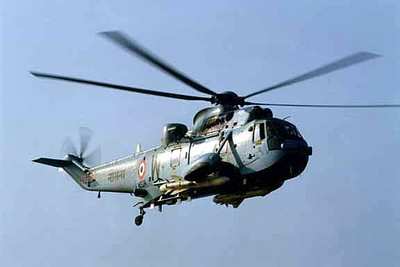Wed, Feb 09, 2005
1998 Embargo Lifted on Harrier, Sikorsky SH-3 Parts
The Indian Navy's Sea Harrier and SH-3 helicopter fleets have
suffered serious spare parts availability problems since the US
imposed sanctions after India's 1998 nuclear test. At times, as
many as 30 to 40-percent of Indian aircraft have been grounded
because of the spares shortages, according to Indian Navy Vice
Chief of Naval Staff Admiral John DeSilva.

The Sea Harriers are the Navy's only combat airplanes, providing
fleet defense and striking power; the Sea King helicopters are
vital to protecting India's growing fleet from hostile submarines.
The Sea Kings are American Sikorsky machines, and the Harriers were
built by an Anglo-American partnership and incorporate many
American components that require periodic servicing.

The word "sanctions" makes everyone think of a total embargo,
but in this case supply was never completely cut off. Instead,
Indian procurement officers had to work through British
intermediaries who had to get individual authorizations to
re-export United States-sourced products to India. This took time
and added a lot of "hurry up and wait" to the Indian naval-aviation
supply system.
While the Indian officers welcome the ability to buy direct,
rather than endure indirect and unresponsive supply lines, the
sanctions experience has made them leery of the USA as a supplier.
The US, however, has three desires: one, to reward India for its
cooperation in the war, which continues out of the public eye; two,
to continue the improvements in bilateral relations begun in 2001;
three, and perhaps most important, to gain a toehold in the growing
Indian arms market.

India's traditional arms suppliers, Russia and France, can
supply many things, but not advanced VSTOL aircraft that will
follow the Harrier in US and European service. The US for its part
would welcome another partner to share the cost -- and the risk --
for the V-35 VSTOL variant. Despite the definite differences
between these nations, the common interests of these two populous
and well-established free nations will continue to bring them
together.
More News
Improvements Stack as Brand Readies for Mass Production Samson Sky updated followers on its flying car progress, describing some of the travails of the wind tunnel as they get clos>[...]
LAHSO An acronym for “Land and Hold Short Operation.” These operations include landing and holding short of an intersecting runway, a taxiway, a predetermined point, or>[...]
Dave Juwel's Aviation Marketing Stories ITBOA BNITBOB ... what does that mean? It's not gibberish, it's a lengthy acronym for "In The Business Of Aviation ... But Not In The Busine>[...]
Aero Linx: Space Medicine Association (SMA) The Space Medicine Branch was founded in 1951 as the first constituent organization of the Aerospace Medical Association (AsMA). In 2006>[...]
Back-Taxi A term used by air traffic controllers to taxi an aircraft on the runway opposite to the traffic flow. The aircraft may be instructed to back-taxi to the beginning of the>[...]
 Samson Sky Hits the Wind Tunnel
Samson Sky Hits the Wind Tunnel ANN's Daily Aero-Term (05.22.24): LAHSO
ANN's Daily Aero-Term (05.22.24): LAHSO Aero-FAQ: Dave Juwel's Aviation Marketing Stories -- ITBOA BNITBOB
Aero-FAQ: Dave Juwel's Aviation Marketing Stories -- ITBOA BNITBOB ANN's Daily Aero-Linx (05.19.24)
ANN's Daily Aero-Linx (05.19.24) ANN's Daily Aero-Term (05.19.24): Back-Taxi
ANN's Daily Aero-Term (05.19.24): Back-Taxi





